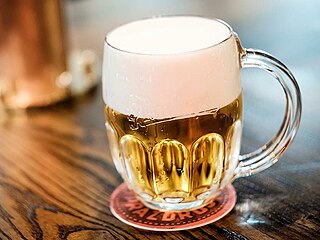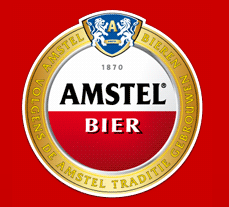
Foster's Lager is an internationally distributed brand of Australian lager. It is owned by the Japanese brewing group Asahi Group Holdings, and is brewed under licence in a number of countries, including its biggest market, the UK, where the European rights to the brand are owned by Heineken International.

Grolsch Brewery , known simply as Grolsch, is a Dutch brewery founded in 1615 by Willem Neerfeldt in Groenlo. In 1895 the de Groen family bought the brewery. They had started their own brewery in Enschede in the early 19th century. It held a significant stake until November 2007. Today the main brewery is located in Enschede.
Topvar Breweries is a beer brewing company in Slovakia. The company was created by the merger of the Šariš and Topvar breweries on 1 January 2007, after both were purchased by global brewing giant SABMiller in 2006. Subsequently, as part of the agreements made with regulators before Anheuser-Busch InBev was allowed to acquire SABMiller in October 2016, Topvar was sold to Asahi Breweries of Japan on December 13, 2016; the deal is expected to close during the first half of 2017.

The Asahi Group Holdings, Ltd. is a Japanese beverage holding company headquartered in Sumida, Tokyo.

Beer has a long history in what is now the Czech Republic, with brewing taking place in Břevnov Monastery in 993. The city of Brno had the right to brew beer from the 12th century, while Plzeň and České Budějovice, had breweries in the 13th century.
Beer in Africa, especially lager, is produced commercially in most African countries, and indigenous people also make varieties of beer. Beer is served in various locales, from neighbourhood shebeens to upscale bars. Many countries have standardized beer bottle sizes, which are cleaned and re-used, so when buying beer at a store, people often must pay a deposit on the bottle and the price of the beer. An alternative to glass-bottle beers is local beer sold in tetra-pak style paper cartons.
Plzeňský Prazdroj, a. s. is a Czech brewery which opened in 1842 in Plzeň, Bohemia. It was the first brewery to produce a pale lager, branded as Pilsner Urquell, which became so popular and was so much copied that more than two-thirds of the beer produced in the world today is pale lager, sometimes named pils, pilsner and pilsener after Pilsner Urquell. The brewery name, Pilsner Urquell, which can be roughly translated into English as "the original source at Pilsen", was adopted as a trademark in 1898. Pilsner Urquell is the largest producer and exporter of beer in the Czech Republic.

Amstel Brewery is a Dutch brewery founded in 1870 on the Mauritskade in Amsterdam. It was taken over by Heineken International in 1968, and the brewing plant closed down in 1982, with production moving to the main Heineken plant at Zoeterwoude.
Tourism in Slovakia offers natural landscapes, mountains, caves, medieval castles and towns, folk architecture, spas and ski resorts.

Šariš Brewery is the largest brewery in Slovakia, located in Veľký Šariš near Prešov. Since January 1, 2007, the company Pivovary Topvar has operated in Slovakia, which is the combination of the existing breweries Pivovar Šariš and Topvar. Šariš Brewery was sold to Asahi Breweries of Japan on December 13, 2016. Asahi Breweries owns 100% of the shares of Pivovary Topvar.
The Stein Brewery was a Slovak brewery, based in Bratislava. It was founded between 1871 and 1876 and closed in 2007. Eventually, Stein became the third largest brewery in Czechoslovakia. The brand is still produced by Steiger Brewery in Vyhne, Slovakia.
Heineken N.V. is a Dutch brewer which owns a worldwide portfolio of over 170 beer brands, mainly pale lager, though some other beer styles are produced. The two largest brands are Heineken and Tecate; though the portfolio includes Amstel, Fosters, Sagres, Cruzcampo, Skopsko, Affligem, Żywiec, Starobrno, Zagorka, Zlatý Bažant, Laško and Birra Moretti.
SABMiller was one of the top five global brewing companies, and had a range of over 150 beers, including international beers such as Pilsner Urquell, and Miller Genuine Draft, and local ones such as Gambrinus and Castle Milk Stout.

Zlatý Bažant is the most exported Slovak beer brand. It was founded in 1969 and is produced at its brewery in Hurbanovo. It was acquired by the Heineken International group in 1995 adding on to the group's repertoire of over 170 beer brands from 125 breweries in 70 countries.

Starobrno Brewery is a Czech brewery located in the city of Brno. It was built as a successor of the brewery founded in 1325, as a part of Cistercian convent. The brewery was named Starobrno Brewery only in the second half of the 19th century. In 2009, Starobrno Brewery produced more than one million hectoliters of beer. The same year, the brewery merged with the Royal Brewery of Krušovice and became a part of the Dutch brewing company Heineken N.V.

The 2014–15 Slovak Cup, also known as Slovnaft Cup for sponsorship reasons, was the 46th edition of the competition. The winners of the competition will qualify for the second qualifying round of the 2015–16 UEFA Europa League.

The Tyskie Brewing Museum or Tyskie Browarium is a museum in Tychy in Silesia, Poland. It was established in 2004. The museum is an Anchor point on the European Route of Industrial Heritage. It is an object of cultural heritage in Silesia (259/10), and a Polish national monument (641660).













